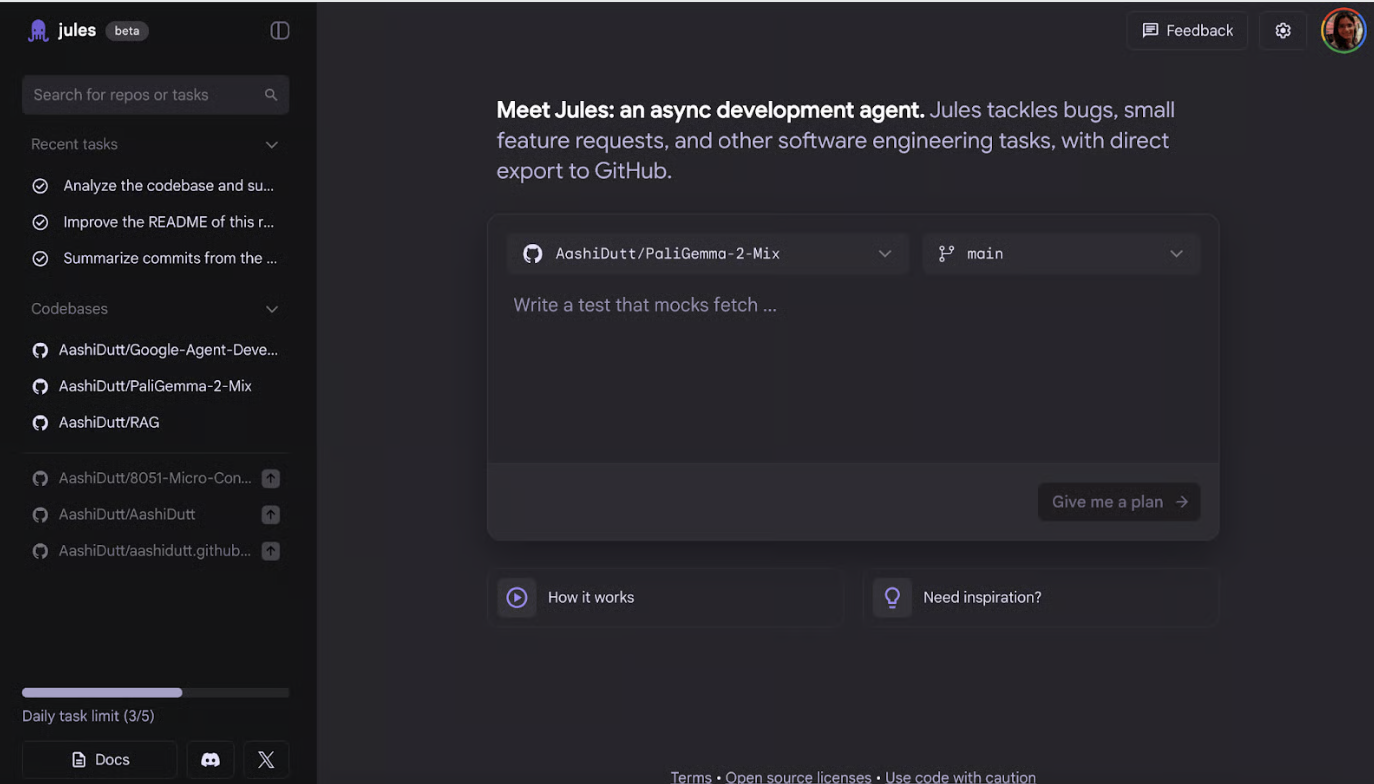Read the full article on DataCamp: Google Jules – A Guide With 3 Practical Examples
Learn how to use Google Jules, a autonomous coding agent powered by Gemini 2.5 Pro, to automate software engineering workflows across your GitHub repository.
What Is Google Jules?
Google Jules is a developer agent that clones your GitHub repository into a secure Google Cloud VM, understands the context of your codebase, and executes complex tasks such as:
- Fixing bugs and typos
- Improving documentation
- Refactoring and dependency updates
- Implementing new features
- Generating audio changelogs from commits
Unlike autocomplete tools, Jules acts as a planning-first autonomous agent—proposing structured plans before making multi-step changes and generating pull requests.
How to Set Up Google Jules
Step 1: Sign In
Head over to the Jules website and sign in with your Google account. Accept the Privacy Notice and continue.
Step 2: Connect to GitHub
Click “Connect Repository” and authorize Jules to access your GitHub account and repositories. You can selectively authorize specific repos or grant org-wide access.
Step 3: Launch the Dashboard
Once authenticated, you’ll see a dashboard where you can:
- View authorized repositories
- Create tasks via natural language
- Pause/resume existing tasks
Note: Beta users can perform up to five tasks per day.
Google Jules: Three Practical Examples
Example 1: Fix Layout and Improve README
Prompt: “Improve the README of this repository by making it more detailed and informative.”
Jules analyzed the codebase and improved the README by:
- Adding missing documentation sections
- Including setup instructions for Python environments
- Rewriting unclear segments for clarity and structure
Once approved, Jules created a diff and pushed a pull request. This is perfect for onboarding contributors or enhancing developer UX.
Example 2: Add a New Feature (Spending Trends Tracker)
Prompt: “Analyze the codebase and suggest a meaningful new feature aligned with the project’s purpose.”
Jules proposed and implemented:
- Data persistence with a CSV file for bill tracking
- Logic to append processed bills and build history
- Hooks for future trend visualizations
Jules executed this plan, generated commit messages, and created a PR—all with minimal user interaction.
Example 3: Generate Audio Changelog
Prompt: “Summarize commits from the past 7 days and generate an audio changelog.”
Jules:
- Pulled commit history
- Summarized author names and module changes
- Used speech synthesis to generate a
.wavfile
Though the voice output was robotic, the concept is powerful—ideal for async teams, sprint recaps, and onboarding.
Jules vs. OpenAI Codex
| Feature | Google Jules | OpenAI Codex |
|---|---|---|
| Interaction Style | Autonomous + Plan-based | Conversational + Iterative |
| Agent Architecture | Gemini 2.5 Pro | o3 (Codex-1) |
| Task Handling | Multi-step, Parallel Tasks | Interactive debugging, one task at a time |
| Pull Request Support | ✅ | ✅ |
| Context Awareness | Full repo clone | Scoped to selected files |
| Use Case Strength | Long workflows, planning, automation | Live prototyping, inline feedback |
Conclusion
Google Jules transforms GitHub workflows by:
- Autonomously fixing layout bugs
- Proposing and implementing full-stack features
- Creating audio commit summaries
As Jules evolves, we anticipate support for richer CI integrations, test coverage plans, and UI previews. For async and structured development, Jules is a game-changer.


Comments